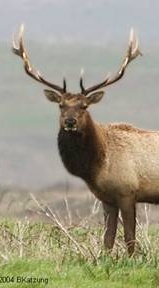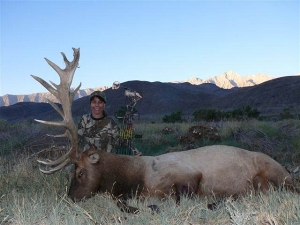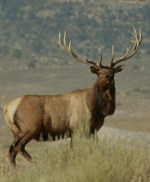Owens Valley

The Owens Valley is located in Inyo County, east-central California. The valley is oriented in a north-south direction, and is approximately 121 miles long and 16 miles wide. The elevation at the north end of the valley is 4,380 ft and at the south end is 3,806 ft. The Sierra Nevada bound the Owens Valley to the west and the White and Inyo Mountains lie to the east; these ranges reach elevations of over 14,000 ft. The Owens Valley is a semi-arid desert environment falling within the rain shadow of the Sierra Nevada. The valley has a continental climate with temperatures often reaching above 100˚F in the summer and dropping to as low as 0˚F in the winter.
Vegetation in the Owens Valley consists of Great Basin and Mojave desert shrub communities. Saltbush (Atriplex spp.), rabbitbrush (Chrysothamnus nauseosum), and sagebrush (Artemisia spp.) dominate the uplands of the valley, while greasewood (Sarcobatus vermiculatus), saltgrass (Distichlis spicata), and shade scale (Atriplex confertifolia) dominate the lowlands. The Owens River flows south through the valley creating a riparian area of willow (Salix spp.), cottonwood (Populus fremontii), and cattail (Typha domingensis) marshes. Cattle graze throughout the valley, although agricultural crops are limited to a few alfalfa fields.
Introduction of Tule Elk into the Owens Valley
In 1933 and early 1934 the California Fish and Game Commission authorized the introduction of 56 tule elk in the middle of the Owens Valley near the town of Aberdeen. The herd grew and rapidly expanded its range.
As elk numbers increased, a bitter conflict arose between those who supported the growth of the elk herd and the valley ranchers who suffered damage to crops, fences, and irrigation equipment. The ranchers wanted the elk removed from the valley; those who supported the presence of the elk wanted the ranchers removed. In 1952, as a compromise, the California Department of Fish and Game agreed to limit the size of the elk herd to between 125 and 275 animals. After several years of deliberation and dispute, the Department agreed to keep the herd below 300 animals. This level was acceptable to the ranchers and was the basis for the official policy of the California Fish and Game Commission for many years. When the total number of elk counted during the annual aerial census exceeded 300, a public hunt was authorized to reduce the number to 250 - 300.
In January 1970 the Owens Valley Interagency Committee on Land and Wildlife was formed to help coordinate the activities of agencies with a mutual interest and varying responsibilities in resource management including the tule elk. Members of this Committee include the Los Angeles Department of Water and Power (DWP), the California Division of Forestry, Inyo National Forest, the U. S. Bureau of Land Management, the California Department of Fish and Game, Inyo and Mono Counties, the University of California, the California Department of Transportation, and other agencies.
Later in the summer of 1970, DWP contracted with Dr. Dale R. McCullough, who had completed a dissertation on the tule elk in 1969, to update information on the Owens Valley tule elk and prepare recommendations for management on DWP lands. The next year, 1971, the Fish and Game Commission, on Dr. McCullough's recommendation, revised its policy to establish a maximum tule elk population in the Owens Valley of 490 animals. The new policy provided for 290 elk in the bottomland herds and 200 elk in the two upland herds, Whitney and Goodale.
History of Hunting Owens Valley Tule Elk
In 1943, the Department attempted to provide depredation relief by recommending public hunting of tule elk in the Valley. From 1943 through 1969, the Commission approved 7 elk hunts in the Owens Valley. These hunts were not well received by farmers, who wanted all the elk removed, or animal preservationists, who objected to the herd reductions. Opposition to these hunts grew and by 1960 concern by tule elk preservationists resulted in the formation of the Committee for the Preservation of Tule Elk. The Committee and other interested groups opposed hunting of tule elk. The conflict between ranchers and the Committee over the status of tule elk and the Committee's opposition to elk hunts continued to grow, resulting in widespread disagreement over the 1969 hunt.
After the adoption of the 1969 tule elk hunt by the Commission, the Committee for the Preservation of Tule Elk sought legislation to prohibit hunting of tule elk. In 1971, the debate surrounding tule elk moved from the Fish and Game Commission to the California State Legislature, which passed the Behr Bill. This bill amended Section 332 and added Section 3951 to the California Fish and Game Code. This law prohibited the take of tule elk until a minimum population size of 2000 animals was attained. In 1976, the United States Congress passed Public Law 94-389, which concurred with the state law and directed federal agencies to make land available for elk reintroduction. In 1977 the Tule Elk Interagency Task Force was formed to coordinate the efforts of the many state and federal agencies responsible for tule elk reintroduction. By 1987 the tule elk population exceeded 2000 animals, and so the legislature amended the Behr Bill.

The increase in elk numbers and occupied range resulted in a situation where at least 12 of the state's tule elk herds caused or continued to cause damage to private property. In response to the increasing level of tule elk damage to property, Assemblyman Hauser introduced legislation (AB 998) in 1987 which amended sections 332 and 3951, Fish and Game Code. AB 998 was approved by the legislature and signed by the governor on September 27, 1987. The statute also requires that, where economic or environmental damage occurs, emphasis shall be placed on managing each tule elk herd at biologically sound levels through the use of relocation, hunting, or other appropriate means determined by the Department.
Section 3951, Fish and Game Code, also requires the Department to prepare management plans for "high priority areas, including, but not limited to Potter Valley and Mendocino County..." The Legislature only defined Potter Valley and Mendocino County as high priority areas and left the responsibility of determining other high priority areas to the Department. In addition to Potter Valley and Mendocino County, the Department identified Grizzly Island, La Panza, Cache Creek, Lone Pine, Tinemaha, and Bishop as other high priority areas. Management plans for these and 8 other areas have been completed and approved by the Department.
In 1987, the statewide tule elk population exceeded 2,000 animals and the Commission established regulations under which a limited number of tule elk would be hunted in 1988 (Fish and Game Commission, Statement of Purpose for Regulatory Action, January 11, 1988). However, in September 1988, a citizens group obtained a court order preventing implementation of the regulations, based primarily on a finding that the Commission's decision did not comply with CEQA. In 1989, the Department prepared an environmental document regarding tule elk hunting, which was circulated for review as required by CEQA. The Commission certified the environmental document and adopted regulations providing for the take of up to 95 tule elk from specific areas in the state (the Bishop and Lone Pine sub-herds and a portion of the herd at Cache Creek). During the 1989 tule elk hunting season 84 elk were taken by hunters.
Annually since 1989, the Department has prepared the appropriate environmental documentation to continue to provide for public hunting of tule elk from specific populations. In 1990, Assemblyman Hauser introduced legislation which was passed by the legislature and signed by the governor (AB 2848), amending Section 332, Fish and Game Code, to allow the Commission to authorize issuance of up to 3 elk tags for fund-raising purposes. All revenue generated by the fund-raising tags is to be used for elk management in California. Since 1990, the Commission has authorized public tule elk hunting at additional locations, including Alameda, Bear Valley, Grizzly Island, Fort Hunter Liggett, La Panza, Mendocino, Santa Clara zones, and within the Independence and Tinemaha zones of the Owens Valley.
Owens Valley Tule Elk Herd Size Recommendations

The recommended herd size is the range in number of elk that can be supported in the herd area over a series of dry years. The recommended number per herd at this time is as follows:
- Bishop 70-100
- Tinemaha 80-100
- Goodale 50-70
- Independence 60-80
- Lone Pine 60-80
- Whitney 40-60
Total: 360-490
References
- Owens Valley Tule Elk Report (PDF)(opens in new tab). 2021. CDFW.
- Bleich, V. C., C. S. Y. Chun, R. W. Anthes, T. E. Evans, and J. K. Fischer. 2001. Visibility bias and development of a sightability model for tule elk. Alces 37:315-327.
- McCullough, D. R. 1969. The tule elk: its history, behavior, and ecology. University of California Publications in Zoology 88:1-209. Berkeley, California.
- California Department of Fish and Game (CDFG). 2011. Draft Statewide Elk Management Plan. Department of Fish and Game. Sacramento office, 1812 9th Street, Sacramento, CA 95811.
- Blankenship, T., D. Koch, and D. Racine. 1986. Owens Valley Tule Elk Management Unit Management Plan. Department of Fish and Game. Bishop office, 407 West Line Street, Bishop, CA 93514.